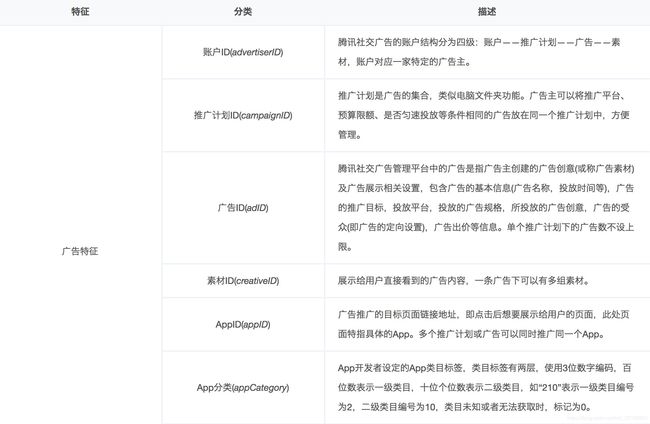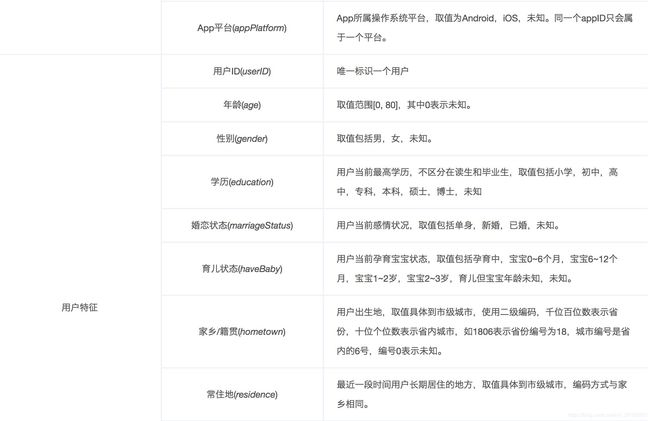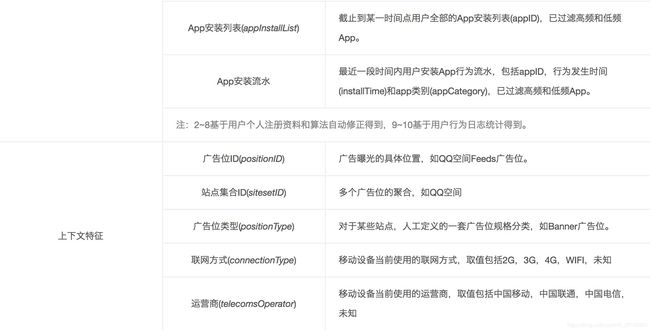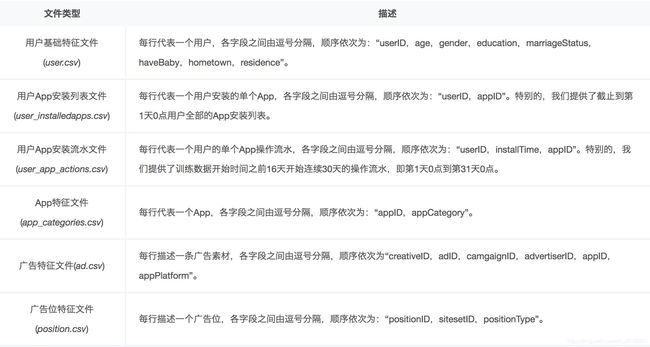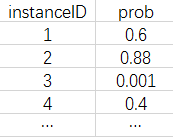机器学习项目 - ctr 电商点击率预估
前言 : 我写的博客基本都以实战为主,每个都可以运行,直接看代码注释理解,不拖泥带水,学习会很快
第一章 腾讯移动App广告转化率预估 -----------------------
题目描述
计算广告是互联网最重要的商业模式之一,广告投放效果通常通过曝光、点击和转化各环节来衡量,大多数广告系统受广告效果数据回流的限制只能通过曝光或点击作为投放效果的衡量标准开展优化。
腾讯社交广告(http://ads.tencent.com)发挥特有的用户识别和转化跟踪数据能力,帮助广告主跟踪广告投放后的转化效果,基于广告转化数据训练转化率预估模型(pCVR,Predicted Conversion Rate),在广告排序中引入pCVR因子优化广告投放效果,提升ROI。
本题目以移动App广告为研究对象,预测App广告点击后被激活的概率:pCVR=P(conversion=1 | Ad,User,Context),即给定广告、用户和上下文情况下广告被点击后发生激活的概率。
数据描述
训练数据
从腾讯社交广告系统中某一连续两周的日志中按照推广中的App和用户维度随机采样。
每一条训练样本即为一条广告点击日志(点击时间用clickTime表示),样本label取值0或1,其中0表示点击后没有发生转化,1表示点击后有发生转化,如果label为1,还会提供转化回流时间(conversionTime,定义详见“FAQ”)。给定特征集如下:
特别的,出于数据安全的考虑,对于userID,appID,特征,以及时间字段,我们不提供原始数据,按照如下方式加密处理:
训练数据文件(train.csv)
每行代表一个训练样本,各字段之间由逗号分隔,顺序依次为:“label,clickTime,conversionTime,creativeID,userID,positionID,connectionType,telecomsOperator”。
当label=0时,conversionTime字段为空字符串。特别的,训练数据时间范围为第17天0点到第31天0点(定义详见下面的“补充说明”)。为了节省存储空间,用户、App、广告和广告位相关信息以独立文件提供(训练数据和测试数据共用),具体如下:
注:若字段取值为0或空字符串均代表未知。(站点集合ID(sitesetID)为0并不表示未知,而是一个特定的站点集合。)
测试数据
从训练数据时段随后1天(即第31天)的广告日志中按照与训练数据同样的采样方式抽取得到,测试数据文件(test.csv)每行代表一个测试样本,各字段之间由逗号分隔,顺序依次为:“instanceID,-1,clickTime,creativeID,userID,positionID,connectionType,telecomsOperator”。其中,instanceID唯一标识一个样本,-1代表label占位使用,表示待预测。
评估方式
通过Logarithmic Loss评估(越小越好),公式如下:
 其中,N是测试样本总数,yi是二值变量,取值0或1,表示第i个样本的label,pi为模型预测第i个样本 label为1的概率。
其中,N是测试样本总数,yi是二值变量,取值0或1,表示第i个样本的label,pi为模型预测第i个样本 label为1的概率。
示例代码如下(Python语言):
import scipy as sp
def logloss(act, pred):
epsilon = 1e-15
pred = sp.maximum(epsilon, pred)
pred = sp.minimum(1-epsilon, pred)
ll = sum(act*sp.log(pred) + sp.subtract(1,act)*sp.log(sp.subtract(1,pred)))
ll = ll * -1.0/len(act)
return ll
提交格式
模型预估结果以zip压缩文件方式提交,内部文件名是submission.csv。每行代表一个测试样本,第一行为header,可以记录本文件相关关键信息,评测时会忽略,从第二行开始各字段之间由逗号分隔,顺序依次为:“instanceID, prob”,其中,instanceID唯一标识一个测试样本,必须升序排列,prob为模型预估的广告转化概率。示例如下:
第二章 CVR预估基线版本 -----------------------
2.1 基于AD统计的版本
# -*- coding: utf-8 -*-
"""
baseline 1: history pCVR of creativeID/adID/camgaignID/advertiserID/appID/appPlatform
"""
import zipfile
import numpy as np
import pandas as pd
"""
pandas中关于DataFrame 去除省略号
#显示所有列
pd.set_option('display.max_columns', None)
#显示所有行
pd.set_option('display.max_rows', None)
#设置value的显示长度为100,默认为50
pd.set_option('max_colwidth',100)
"""
pd.set_option('display.max_columns', None)
# 载入数据
dfTrain = pd.read_csv('data/train.csv')
dfTest = pd.read_csv('data/test.csv')
dfAd = pd.read_csv('data/ad.csv')
# 处理数据
"""merger() 函数相当于数据库的左右连接,按照creativeID 相同的数据来凝结为一行"""
dfTrain = pd.merge(dfTrain, dfAd, on='creativeID')
dfTest = pd.merge(dfTest, dfAd,on='creativeID')
y_train = dfTrain['label'].values # [0 0 0 ... 0 0 0]
# 创建模型
key = 'appID'
"""
groupby(): 将数据进行排列分组,数据按照appid,
"""
dfCvr = dfTrain.groupby(key).apply(lambda df: np.mean(df['label'])).reset_index()
dfCvr.columns = [key, 'avg_cvr']
dfTest = pd.merge(dfTest, dfCvr, how='left', on=key)
dfTest['avg_cvr'].fillna(np.mean(dfTrain['label']), inplace=True)
proba_test = dfTest['avg_cvr'].values
# submission
df = pd.DataFrame({"instanceID": dfTest['instanceID'].values, "proba": proba_test})
df.sort_values("instanceID", inplace=True)
print(df.head(10))
# df.to_csv("submission.csv", index=False)
# with zipfile.ZipFile('submission.zip', 'w') as fout:
# fout.write('submission.csv', compress_type=zipfile.ZIP_DEFLATED)得分
| Submission | 描述 | 初赛A | 初赛B | 决赛A | 决赛B |
|---|---|---|---|---|---|
| baseline 2.1 | ad 统计 | 0.10988 | - | - | - |
2.2 AD+LR版本
# -*- coding: utf-8 -*-
"""
baseline 2: ad.csv (creativeID/adID/camgaignID/advertiserID/appID/appPlatform) + lr
"""
import zipfile
import pandas as pd
from scipy import sparse
from sklearn.preprocessing import OneHotEncoder
from sklearn.linear_model import LogisticRegression
pd.set_option('display.max_columns', None)
# 载入数据
dfTrain = pd.read_csv('data/train.csv')
dfTest = pd.read_csv('data/test.csv')
dfAd = pd.read_csv('data/ad.csv')
# 处理数据
"""merger() 函数相当于数据库的左右连接,按照creativeID 相同的数据来凝结为一行"""
dfTrain = pd.merge(dfTrain, dfAd, on='creativeID')
dfTest = pd.merge(dfTest, dfAd,on='creativeID')
y_train = dfTrain['label'].values
# feature engineering/encoding
enc = OneHotEncoder()
feats = ["creativeID", "adID", "camgaignID", "advertiserID", "appID", "appPlatform"]
for i, feat in enumerate(feats):
x_train = enc.fit_transform(dfTrain[feat].values.reshape(-1, 1)) # (0, 2966) 1.0
x_test = enc.transform(dfTest[feat].values.reshape(-1,1))
if i == 0:
X_train, X_test = x_train, x_test
else:
X_train, X_test = sparse.hstack((X_train, x_train)), sparse.hstack((X_test, x_test))
# 模型训练
lr = LogisticRegression()
lr.fit(X_train, y_train)
proba_test = lr.predict_proba(X_test)[:, 1]
# submission
df = pd.DataFrame({"instanceID": dfTest["instanceID"].values, "proba": proba_test})
df.sort_values("instanceID", inplace=True)
df.to_csv('submission.csv', index=False)
with zipfile.ZipFile('submission.zip', 'w') as fout:
fout.write('submission.csv', compress_type=zipfile.ZIP_DEFLATED)
得分
| Submission | 描述 | 初赛A | 初赛B | 决赛A | 决赛B |
|---|---|---|---|---|---|
| baseline 2.2 | ad + lr | 0.10743 | - | - | - |
第三章 特征工程与机器学习建模 -----------------------
3.1 代码实战
import os
import warnings
import numpy as np
# x-列最小值)/ (列最大值-列最小值), value在0-1, MinMaxScaler().fit_transform(iris.data)
import pandas as pd
import scipy as sp
# 特征二值化 - 大于阀值转为1,小于等于阀值为0
pd.set_option('display.max_columns', None)
# 随机森林建模&&特征重要度排序
# 随机森林调参
from sklearn.model_selection import GridSearchCV
# Xgboost调参
import xgboost as xgb
# 我们可以看到正负样本数量相差非常大,数据严重unbalanced
from blagging import BlaggingClassifier
""" 文件读取 """
def read_csv_file(filname, logging=False):
data = pd.read_csv(filname)
if logging :
print(data.head(5))
print(data.columns.values)
print(data.describe())
print(data.info())
return data
""" 数据的处理 """
# 第一类编码
def categories_process_first_class(cate):
cate = str(cate)
if len(cate) == 1:
if int(cate) == 0:
return 0
else:
return int(cate[0])
# 第二类编码
def categories_process_second_class(cate):
cate = str(cate)
if len(cate) < 3:
return 0
else:
return int(cate[1:])
# 年龄切断处理
def age_process(age):
age = int(age)
if age == 0:
return 0
if age < 15:
return 1
elif age < 25:
return 2
elif age < 40:
return 3
elif age < 60:
return 4
else:
return 5
# 省份数据处理
def process_province(hometown):
hometown = str(hometown)
province = int(hometown[0:2])
return province
# 城市
def process_city(hometown):
hometown = str(hometown)
if len(hometown) > 1:
province = int(hometown[2:])
else:
province = 0
return province
# 几点钟
def get_time_day(t):
t = str(t)
t = int(t[0:2])
return t
# 一天切分成4段
def get_time_hour(t):
t = str(t)
t = int(t[2:4])
if t < 6:
return 0
if t < 12:
return 1
elif t < 18:
return 2
else:
return 3
# 评估与计算logloss
def logloss(act, pred):
epsilon = 1e-15
pred = sp.maximum(epsilon, pred)
pred = sp.minimum(1-epsilon, pred)
ll = sum(act*sp.log(pred) + sp.subtract(1, act)*sp.log(sp.subtract(1,pred)))
ll = ll * -1.0 / len(act)
return ll
train_data = read_csv_file('data/train.csv', logging=False) # 读取train_data和ad
ad = read_csv_file('data/ad.csv', logging=False)
app_categories = read_csv_file('data/app_categories.csv', logging=False)
app_categories['app_categories_first_class'] = app_categories['appCategory'].apply(categories_process_first_class)
# ['appID' 'appCategory' 'app_categories_first_class' 'app_categories_second_class']
app_categories['app_categories_second_class'] = app_categories['appCategory'].apply(categories_process_second_class)
user = read_csv_file('data/user.csv', logging=False)
""" 画年龄分布柱状图
age_obj = user.age.value_counts()
plt.bar(age_obj.index, age_obj.values.tolist())
plt.show()
"""
# 用户信息处理
user['age_process'] = user['age'].apply(age_process)
user['hometown_province'] = user['hometown'].apply(process_province)
user['hometown_city'] = user['hometown'].apply(process_city)
user["residence_province"] = user['residence'].apply(process_province)
user["residence_city"] = user['residence'].apply(process_city)
train_data['clickTime_day'] = train_data['clickTime'].apply(get_time_day)
train_data['clickTime_hour'] = train_data['clickTime'].apply(get_time_hour)
#test_data
test_data = read_csv_file('./data/test.csv', False)
test_data['clickTime_day'] = test_data['clickTime'].apply(get_time_day)
test_data['clickTime_hour'] = test_data['clickTime'].apply(get_time_hour)
# 全部合并
train_user = pd.merge(train_data, user, on='userID')
train_user_ad = pd.merge(train_user, ad, on='creativeID')
train_user_ad_app = pd.merge(train_user_ad, app_categories, on='appID')
# 取出数据和 label
x_user_ad_app = train_user_ad_app.loc[:, ['creativeID','userID','positionID',
'connectionType','telecomsOperator','clickTime_day','clickTime_hour','age', 'gender' ,'education',
'marriageStatus' ,'haveBaby' , 'residence' ,'age_process',
'hometown_province', 'hometown_city','residence_province', 'residence_city',
'adID', 'camgaignID', 'advertiserID', 'appID' ,'appPlatform' ,
'app_categories_first_class' ,'app_categories_second_class']]
x_user_ad_app = x_user_ad_app.values
print(x_user_ad_app)
x_user_ad_app = np.array(x_user_ad_app, dtype='int32')
print(x_user_ad_app)
# 标签部分
y_user_ad_app = train_user_ad_app.loc[:, ['label']].values
"""
# 随机森林建模&&特征重要度排序 用RF 计算特征重要度
feat_labels = np.array(['creativeID','userID','positionID',
'connectionType','telecomsOperator','clickTime_day','clickTime_hour','age', 'gender' ,'education',
'marriageStatus' ,'haveBaby' , 'residence' ,'age_process',
'hometown_province', 'hometown_city','residence_province', 'residence_city',
'adID', 'camgaignID', 'advertiserID', 'appID' ,'appPlatform' ,
'app_categories_first_class' ,'app_categories_second_class'])
# 随机森林
forest = RandomForestClassifier(n_estimators=100, random_state=0, n_jobs=-1)
forest.fit(x_user_ad_app, y_user_ad_app.reshape(y_user_ad_app.shape[0],))
importances = forest.feature_importances_
indices = np.argsort(importances)[::-1]
for f in range(x_user_ad_app.shape[1]):
print("%2d) %-*s %f" % (f+1, 30, feat_labels[indices[f]], importances[indices[f]]))
plt.title('Feature Importances')
plt.bar(range(x_user_ad_app.shape[1]), importances[indices], color='lightblue', align='center')
plt.xticks(range(x_user_ad_app.shape[1]), feat_labels[indices], rotation=90)
plt.xlim(-1, x_user_ad_app.shape[1])
plt.tight_layout()
plt.savefig('random_forest.png', dpi=300)
plt.show()
"""
"""
随机森林调参
param_grid = {
'n_estimators': [10, 100, 500, 1000],
'max_features': [0.6, 0.7, 0.8, 0.9]
}
rf = RandomForestClassifier()
rfc = GridSearchCV(rf, param_grid, scoring='neg_log_loss', cv=3, n_jobs=2)
rfc.fit(x_user_ad_app, y_user_ad_app.shape(y_user_ad_app[0],))
print(rfc.best_score_)
print(rfc.best_params_)
"""
"""
Xgboost 调参
"""
os.environ['OMP_NUM_THREADS'] = '8' # 开启并行训练
rng = np.random.RandomState(4315)
warnings.filterwarnings('ignore')
param_grid = {
"max_depth": [3,4,5,7,9],
"n_estimators": [10, 50, 100, 400, 800, 1000, 1200],
"learning_rate": [0.1, 0.2, 0.3],
"gamma": [0, 0.2],
"subsample": [0.8, 1],
"colsample_bylevel": [0.8, 1]
}
xgb_model = xgb.XGBClassifier()
rgs = GridSearchCV(xgb_model, param_grid, n_jobs=-1)
rgs.fit(x_user_ad_app, y_user_ad_app) # fit(x,y)
print(rgs.best_score_)
print(rgs.best_params_)
# 正负样本比
positive_num = train_user_ad_app[train_user_ad_app['label'] == 1].values.shape[0]
negative_num = train_user_ad_app[train_user_ad_app['label'] == 0].values.shape[0]
print(negative_num / float(positive_num))
"""
我们用Bagging修正过后,处理不均衡样本的B(l)agging来进行训练和实验
------------后面的这段程序就开始看不懂了--------------
"""
# 处理unbalanced 的classifier
classifier = BlaggingClassifier(n_jobs=-1)
classifier.fit(x_user_ad_app, y_user_ad_app)
classifier.predict_proba(x_test_clean)
# 预测
test_data = pd.merge(test_data, user, on='userID')
test_user_ad = pd.merge(test_data, ad,on='creativeID')
test_user_ad_app = pd.merge(test_user_ad, app_categories, on='appID')
x_test_clean = test_user_ad_app.loc[:, ['creativeID','userID','positionID',
'connectionType','telecomsOperator','clickTime_day','clickTime_hour','age', 'gender' ,'education',
'marriageStatus' ,'haveBaby' , 'residence' ,'age_process',
'hometown_province', 'hometown_city','residence_province', 'residence_city',
'adID', 'camgaignID', 'advertiserID', 'appID' ,'appPlatform' ,
'app_categories_first_class' ,'app_categories_second_class']].values
x_test_clean = np.array(x_test_clean, dtype='int32')
result_predict_prob = []
result_predict = []
for i in range(scale):
result_indiv = clfs[i].predict(x_test_clean)
result_indiv_proba = clfs[i].predict_proba(x_test_clean)[:,1]
result_predict.append(result_indiv_proba)
result_indiv_proba = np.reshape(result_predict_prob, [-1,scale])
result_predict = np.reshape(result_predict,[-1, scale])
result_predict_prob = np.mean(result_predict_prob, axis=1)
result_predict = max_count(result_predict)
result_predict_prob = np.array(result_predict_prob).reshape([-1,1])
test_data['prob'] = result_predict_prob
test_data = test_data.loc[:,['instanceID','prob']]
test_data.to_csv('predict.csv',index=False)
print "prediction done!"
第四章 利用神经网络进行计算广告预测 - LR模型 FM模型 FNN模型 FNN1模型 FNN2模型 CCPM 模型
4.1 数据描述
make-ipinyou-data
This project is to formalise the iPinYou RTB data into a standard format for further
researches.
百度云数据地址
http://pan.baidu.com/s/1kTwX2mF
Step 0
Go to data.computational-advertising.org to download ipinyou.contest.dataset.zip .
Unzip it and get the folder ipinyou.contest.dataset .
Step 1
Update the soft link for the folder ipinyou.contest.dataset in original-data .
weinan@ZHANG:~/Project/make-ipinyou-data/original-data$ ln -sfn
~/Data/ipinyou.contest.dataset ipinyou.contest.dataset Under make-ipinyoudata/
original-data/ipinyou.contest.dataset there should be the original dataset
files like this: weinan@ZHANG:~/Project/make-ipinyou-data/originaldata/
ipinyou.contest.dataset$ ls algo.submission.demo.tar.bz2 README
testing2nd training3rd city.cn.txt region.cn.txt testing3rd
user.profile.tags.cn.txt city.en.txt region.en.txt training1st
user.profile.tags.en.txt files.md5 testing1st training2nd You do not need to
further unzip the packages in the subfolders.
Step 2
Under make-ipinyou-data folder, just run make all .
Note: The user agent parser used in formalizeua.py uses the python package useragents.
After the program finished, the total size of the folder will be 14G. The files under makeipinyou-
data should be like this: weinan@ZHANG:~/Project/make-ipinyou-data$ ls
1458 2261 2997 3386 3476 LICENSE mkyzxdata.sh python schema.txt 2259 2821
3358 3427 all Makefile original-data README.md Normally, we only do experiment
for each campaign (e.g. 1458 ). all is just the merge of all the campaigns. You can delete
all if you think it is unuseful in your experiment.
Use of the data
We use campaign 1458 as example here. weinan@ZHANG:~/Project/make-ipinyoudata/
1458$ ls featindex.txt test.log.txt test.yzx.txt train.log.txt
train.yzx.txt * train.log.txt and test.log.txt are the formalised string data for
each row (record) in train and test. The first column is whether the user click the ad or not.
The 14th column is the winning price for this auction. * featindex.txt maps the features
to their indexes. For example, 8:115.45.195.* 29 means that the 8th column in
train.log.txt with the string 115.45.195.* maps to feature index 29 . *
train.yzx.txt and test.yzx.txt are the mapped vector data for train.log.txt and
test.log.txt . The format is y:click, z:wining_price, and x:features. Such data is in the
standard form as introduced in iPinYou Benchmarking.
For any questions, please report the issues or contact Weinan Zhang.
4.2 代码实战
1. main.py
import numpy as np
from sklearn.metrics import roc_auc_score
import utils
from models import LR, FM, PNN1, PNN2, FNN, CCPM
train_file = '../data/train.yx.txt'
test_file = '../data/test.yx.txt'
# fm_model_file = '../data/fm.model.txt'
input_dim = utils.INPUT_DIM
train_data = utils.read_data(train_file)
train_data = utils.shuffle(train_data)
test_data = utils.read_data(test_file)
if train_data[1].ndim > 1:
print 'label must be 1-dim'
exit(0)
print('read finish')
train_size = train_data[0].shape[0]
test_size = test_data[0].shape[0]
num_feas = len(utils.FIELD_SIZES)
min_round = 1
num_round = 1000
early_stop_round = 50
batch_size = 1024
field_sizes = utils.FIELD_SIZES
field_offsets = utils.FIELD_OFFSETS
def train(model):
history_score = []
for i in range(num_round):
fetches = [model.optimizer, model.loss]
if batch_size > 0:
ls = []
for j in range(train_size / batch_size + 1):
X_i, y_i = utils.slice(train_data, j * batch_size, batch_size)
_, l = model.run(fetches, X_i, y_i)
ls.append(l)
elif batch_size == -1:
X_i, y_i = utils.slice(train_data)
_, l = model.run(fetches, X_i, y_i)
ls = [l]
train_preds = model.run(model.y_prob, utils.slice(train_data)[0])
test_preds = model.run(model.y_prob, utils.slice(test_data)[0])
train_score = roc_auc_score(train_data[1], train_preds)
test_score = roc_auc_score(test_data[1], test_preds)
print('[%d]\tloss (with l2 norm):%f\ttrain-auc: %f\teval-auc: %f' % (i, np.mean(ls), train_score, test_score))
history_score.append(test_score)
if i > min_round and i > early_stop_round:
if np.argmax(history_score) == i - early_stop_round and history_score[-1] - history_score[
-1 * early_stop_round] < 1e-5:
print('early stop\nbest iteration:\n[%d]\teval-auc: %f' % (
np.argmax(history_score), np.max(history_score)))
break
algo = 'pnn2'
if algo == 'lr':
lr_params = {
'input_dim': input_dim,
'opt_algo': 'gd',
'learning_rate': 0.01,
'l2_weight': 0,
'random_seed': 0
}
model = LR(**lr_params)
elif algo == 'fm':
fm_params = {
'input_dim': input_dim,
'factor_order': 10,
'opt_algo': 'gd',
'learning_rate': 0.1,
'l2_w': 0,
'l2_v': 0,
}
model = FM(**fm_params)
elif algo == 'fnn':
fnn_params = {
'layer_sizes': [field_sizes, 10, 1],
'layer_acts': ['tanh', 'none'],
'drop_out': [0, 0],
'opt_algo': 'gd',
'learning_rate': 0.1,
'layer_l2': [0, 0],
'random_seed': 0
}
model = FNN(**fnn_params)
elif algo == 'ccpm':
ccpm_params = {
'layer_sizes': [field_sizes, 10, 5, 3],
'layer_acts': ['tanh', 'tanh', 'none'],
'drop_out': [0, 0, 0],
'opt_algo': 'gd',
'learning_rate': 0.1,
'random_seed': 0
}
model = CCPM(**ccpm_params)
elif algo == 'pnn1':
pnn1_params = {
'layer_sizes': [field_sizes, 10, 1],
'layer_acts': ['tanh', 'none'],
'drop_out': [0, 0],
'opt_algo': 'gd',
'learning_rate': 0.1,
'layer_l2': [0, 0],
'kernel_l2': 0,
'random_seed': 0
}
model = PNN1(**pnn1_params)
elif algo == 'pnn2':
pnn2_params = {
'layer_sizes': [field_sizes, 10, 1],
'layer_acts': ['tanh', 'none'],
'drop_out': [0, 0],
'opt_algo': 'gd',
'learning_rate': 0.01,
'layer_l2': [0, 0],
'kernel_l2': 0,
'random_seed': 0
}
model = PNN2(**pnn2_params)
if algo in {'fnn', 'ccpm', 'pnn1', 'pnn2'}:
train_data = utils.split_data(train_data)
test_data = utils.split_data(test_data)
train(model)
# X_i, y_i = utils.slice(train_data, 0, 100)
# fetches = [model.tmp1, model.tmp2]
# tmp1, tmp2 = model.run(fetches, X_i, y_i)
# print tmp1.shape
# print tmp2.shape
2. models.py
import sys
if sys.version[0] == '2':
import cPickle as pkl
else:
import pickle as pkl
import numpy as np
import tensorflow as tf
import utils
dtype = utils.DTYPE
class Model:
def __init__(self):
self.sess = None
self.X = None
self.y = None
self.layer_keeps = None
self.vars = None
self.keep_prob_train = None
self.keep_prob_test = None
def run(self, fetches, X=None, y=None, mode='train'):
feed_dict = {}
if type(self.X) is list:
for i in range(len(X)):
feed_dict[self.X[i]] = X[i]
else:
feed_dict[self.X] = X
if y is not None:
feed_dict[self.y] = y
if self.layer_keeps is not None:
if mode == 'train':
feed_dict[self.layer_keeps] = self.keep_prob_train
elif mode == 'test':
feed_dict[self.layer_keeps] = self.keep_prob_test
return self.sess.run(fetches, feed_dict)
def dump(self, model_path):
var_map = {}
for name, var in self.vars.iteritems():
var_map[name] = self.run(var)
pkl.dump(var_map, open(model_path, 'wb'))
print('model dumped at', model_path)
class LR(Model):
def __init__(self, input_dim=None, output_dim=1, init_path=None, opt_algo='gd', learning_rate=1e-2, l2_weight=0,
random_seed=None):
Model.__init__(self)
init_vars = [('w', [input_dim, output_dim], 'tnormal', dtype),
('b', [output_dim], 'zero', dtype)]
self.graph = tf.Graph()
with self.graph.as_default():
if random_seed is not None:
tf.set_random_seed(random_seed)
self.X = tf.sparse_placeholder(dtype)
self.y = tf.placeholder(dtype)
self.vars = utils.init_var_map(init_vars, init_path)
w = self.vars['w']
b = self.vars['b']
xw = tf.sparse_tensor_dense_matmul(self.X, w)
logits = tf.reshape(xw + b, [-1])
self.y_prob = tf.sigmoid(logits)
self.loss = tf.reduce_mean(
tf.nn.sigmoid_cross_entropy_with_logits(labels=self.y, logits=logits)) + \
l2_weight * tf.nn.l2_loss(xw)
self.optimizer = utils.get_optimizer(opt_algo, learning_rate, self.loss)
config = tf.ConfigProto()
config.gpu_options.allow_growth = True
self.sess = tf.Session(config=config)
tf.global_variables_initializer().run(session=self.sess)
class FM(Model):
def __init__(self, input_dim=None, output_dim=1, factor_order=10, init_path=None, opt_algo='gd', learning_rate=1e-2,
l2_w=0, l2_v=0, random_seed=None):
Model.__init__(self)
init_vars = [('w', [input_dim, output_dim], 'tnormal', dtype),
('v', [input_dim, factor_order], 'tnormal', dtype),
('b', [output_dim], 'zero', dtype)]
self.graph = tf.Graph()
with self.graph.as_default():
if random_seed is not None:
tf.set_random_seed(random_seed)
self.X = tf.sparse_placeholder(dtype)
self.y = tf.placeholder(dtype)
self.vars = utils.init_var_map(init_vars, init_path)
w = self.vars['w']
v = self.vars['v']
b = self.vars['b']
X_square = tf.SparseTensor(self.X.indices, tf.square(self.X.values), tf.to_int64(tf.shape(self.X)))
xv = tf.square(tf.sparse_tensor_dense_matmul(self.X, v))
p = 0.5 * tf.reshape(
tf.reduce_sum(xv - tf.sparse_tensor_dense_matmul(X_square, tf.square(v)), 1),
[-1, output_dim])
xw = tf.sparse_tensor_dense_matmul(self.X, w)
logits = tf.reshape(xw + b + p, [-1])
self.y_prob = tf.sigmoid(logits)
self.loss = tf.reduce_mean(
tf.nn.sigmoid_cross_entropy_with_logits(logits=logits, labels=self.y)) + \
l2_w * tf.nn.l2_loss(xw) + \
l2_v * tf.nn.l2_loss(xv)
self.optimizer = utils.get_optimizer(opt_algo, learning_rate, self.loss)
config = tf.ConfigProto()
config.gpu_options.allow_growth = True
self.sess = tf.Session(config=config)
tf.global_variables_initializer().run(session=self.sess)
class FNN(Model):
def __init__(self, layer_sizes=None, layer_acts=None, drop_out=None, layer_l2=None, init_path=None, opt_algo='gd',
learning_rate=1e-2, random_seed=None):
Model.__init__(self)
init_vars = []
num_inputs = len(layer_sizes[0])
factor_order = layer_sizes[1]
for i in range(num_inputs):
layer_input = layer_sizes[0][i]
layer_output = factor_order
init_vars.append(('w0_%d' % i, [layer_input, layer_output], 'tnormal', dtype))
init_vars.append(('b0_%d' % i, [layer_output], 'zero', dtype))
init_vars.append(('w1', [num_inputs * factor_order, layer_sizes[2]], 'tnormal', dtype))
init_vars.append(('b1', [layer_sizes[2]], 'zero', dtype))
for i in range(2, len(layer_sizes) - 1):
layer_input = layer_sizes[i]
layer_output = layer_sizes[i + 1]
init_vars.append(('w%d' % i, [layer_input, layer_output], 'tnormal', dtype))
init_vars.append(('b%d' % i, [layer_output], 'zero', dtype))
self.graph = tf.Graph()
with self.graph.as_default():
if random_seed is not None:
tf.set_random_seed(random_seed)
self.X = [tf.sparse_placeholder(dtype) for i in range(num_inputs)]
self.y = tf.placeholder(dtype)
self.keep_prob_train = 1 - np.array(drop_out)
self.keep_prob_test = np.ones_like(drop_out)
self.layer_keeps = tf.placeholder(dtype)
self.vars = utils.init_var_map(init_vars, init_path)
w0 = [self.vars['w0_%d' % i] for i in range(num_inputs)]
b0 = [self.vars['b0_%d' % i] for i in range(num_inputs)]
xw = [tf.sparse_tensor_dense_matmul(self.X[i], w0[i]) for i in range(num_inputs)]
x = tf.concat([xw[i] + b0[i] for i in range(num_inputs)], 1)
l = tf.nn.dropout(
utils.activate(x, layer_acts[0]),
self.layer_keeps[0])
for i in range(1, len(layer_sizes) - 1):
wi = self.vars['w%d' % i]
bi = self.vars['b%d' % i]
l = tf.nn.dropout(
utils.activate(
tf.matmul(l, wi) + bi,
layer_acts[i]),
self.layer_keeps[i])
l = tf.reshape(l, [-1])
self.y_prob = tf.sigmoid(l)
self.loss = tf.reduce_mean(
tf.nn.sigmoid_cross_entropy_with_logits(logits=l, labels=self.y))
if layer_l2 is not None:
# for i in range(num_inputs):
self.loss += layer_l2[0] * tf.nn.l2_loss(tf.concat(xw, 1))
for i in range(1, len(layer_sizes) - 1):
wi = self.vars['w%d' % i]
# bi = self.vars['b%d' % i]
self.loss += layer_l2[i] * tf.nn.l2_loss(wi)
self.optimizer = utils.get_optimizer(opt_algo, learning_rate, self.loss)
config = tf.ConfigProto()
config.gpu_options.allow_growth = True
self.sess = tf.Session(config=config)
tf.global_variables_initializer().run(session=self.sess)
class CCPM(Model):
def __init__(self, layer_sizes=None, layer_acts=None, drop_out=None, init_path=None, opt_algo='gd',
learning_rate=1e-2, random_seed=None):
Model.__init__(self)
init_vars = []
num_inputs = len(layer_sizes[0])
embedding_order = layer_sizes[1]
for i in range(num_inputs):
layer_input = layer_sizes[0][i]
layer_output = embedding_order
init_vars.append(('w0_%d' % i, [layer_input, layer_output], 'tnormal', dtype))
init_vars.append(('b0_%d' % i, [layer_output], 'zero', dtype))
init_vars.append(('f1', [embedding_order, layer_sizes[2], 1, 2], 'tnormal', dtype))
init_vars.append(('f2', [embedding_order, layer_sizes[3], 2, 2], 'tnormal', dtype))
init_vars.append(('w1', [2 * 3 * embedding_order, 1], 'tnormal', dtype))
init_vars.append(('b1', [1], 'zero', dtype))
self.graph = tf.Graph()
with self.graph.as_default():
if random_seed is not None:
tf.set_random_seed(random_seed)
self.X = [tf.sparse_placeholder(dtype) for i in range(num_inputs)]
self.y = tf.placeholder(dtype)
self.keep_prob_train = 1 - np.array(drop_out)
self.keep_prob_test = np.ones_like(drop_out)
self.layer_keeps = tf.placeholder(dtype)
self.vars = utils.init_var_map(init_vars, init_path)
w0 = [self.vars['w0_%d' % i] for i in range(num_inputs)]
b0 = [self.vars['b0_%d' % i] for i in range(num_inputs)]
l = tf.nn.dropout(
utils.activate(
tf.concat([tf.sparse_tensor_dense_matmul(self.X[i], w0[i]) + b0[i]
for i in range(num_inputs)], 1),
layer_acts[0]),
self.layer_keeps[0])
l = tf.transpose(tf.reshape(l, [-1, num_inputs, embedding_order, 1]), [0, 2, 1, 3])
f1 = self.vars['f1']
l = tf.nn.conv2d(l, f1, [1, 1, 1, 1], 'SAME')
l = tf.transpose(
utils.max_pool_4d(
tf.transpose(l, [0, 1, 3, 2]),
num_inputs / 2),
[0, 1, 3, 2])
f2 = self.vars['f2']
l = tf.nn.conv2d(l, f2, [1, 1, 1, 1], 'SAME')
l = tf.transpose(
utils.max_pool_4d(
tf.transpose(l, [0, 1, 3, 2]), 3),
[0, 1, 3, 2])
l = tf.nn.dropout(
utils.activate(
tf.reshape(l, [-1, embedding_order * 3 * 2]),
layer_acts[1]),
self.layer_keeps[1])
w1 = self.vars['w1']
b1 = self.vars['b1']
l = tf.nn.dropout(
utils.activate(
tf.matmul(l, w1) + b1,
layer_acts[2]),
self.layer_keeps[2])
l = tf.reshape(l, [-1])
self.y_prob = tf.sigmoid(l)
self.loss = tf.reduce_mean(
tf.nn.sigmoid_cross_entropy_with_logits(logits=l, labels=self.y))
self.optimizer = utils.get_optimizer(opt_algo, learning_rate, self.loss)
config = tf.ConfigProto()
config.gpu_options.allow_growth = True
self.sess = tf.Session(config=config)
tf.global_variables_initializer().run(session=self.sess)
class PNN1(Model):
def __init__(self, layer_sizes=None, layer_acts=None, drop_out=None, layer_l2=None, kernel_l2=None, init_path=None,
opt_algo='gd', learning_rate=1e-2, random_seed=None):
Model.__init__(self)
init_vars = []
num_inputs = len(layer_sizes[0])
factor_order = layer_sizes[1]
for i in range(num_inputs):
layer_input = layer_sizes[0][i]
layer_output = factor_order
init_vars.append(('w0_%d' % i, [layer_input, layer_output], 'tnormal', dtype))
init_vars.append(('b0_%d' % i, [layer_output], 'zero', dtype))
init_vars.append(('w1', [num_inputs * factor_order, layer_sizes[2]], 'tnormal', dtype))
init_vars.append(('k1', [num_inputs, layer_sizes[2]], 'tnormal', dtype))
init_vars.append(('b1', [layer_sizes[2]], 'zero', dtype))
for i in range(2, len(layer_sizes) - 1):
layer_input = layer_sizes[i]
layer_output = layer_sizes[i + 1]
init_vars.append(('w%d' % i, [layer_input, layer_output], 'tnormal',))
init_vars.append(('b%d' % i, [layer_output], 'zero', dtype))
self.graph = tf.Graph()
with self.graph.as_default():
if random_seed is not None:
tf.set_random_seed(random_seed)
self.X = [tf.sparse_placeholder(dtype) for i in range(num_inputs)]
self.y = tf.placeholder(dtype)
self.keep_prob_train = 1 - np.array(drop_out)
self.keep_prob_test = np.ones_like(drop_out)
self.layer_keeps = tf.placeholder(dtype)
self.vars = utils.init_var_map(init_vars, init_path)
w0 = [self.vars['w0_%d' % i] for i in range(num_inputs)]
b0 = [self.vars['b0_%d' % i] for i in range(num_inputs)]
xw = [tf.sparse_tensor_dense_matmul(self.X[i], w0[i]) for i in range(num_inputs)]
x = tf.concat([xw[i] + b0[i] for i in range(num_inputs)], 1)
l = tf.nn.dropout(
utils.activate(x, layer_acts[0]),
self.layer_keeps[0])
w1 = self.vars['w1']
k1 = self.vars['k1']
b1 = self.vars['b1']
p = tf.reduce_sum(
tf.reshape(
tf.matmul(
tf.reshape(
tf.transpose(
tf.reshape(l, [-1, num_inputs, factor_order]),
[0, 2, 1]),
[-1, num_inputs]),
k1),
[-1, factor_order, layer_sizes[2]]),
1)
l = tf.nn.dropout(
utils.activate(
tf.matmul(l, w1) + b1 + p,
layer_acts[1]),
self.layer_keeps[1])
for i in range(2, len(layer_sizes) - 1):
wi = self.vars['w%d' % i]
bi = self.vars['b%d' % i]
l = tf.nn.dropout(
utils.activate(
tf.matmul(l, wi) + bi,
layer_acts[i]),
self.layer_keeps[i])
l = tf.reshape(l, [-1])
self.y_prob = tf.sigmoid(l)
self.loss = tf.reduce_mean(
tf.nn.sigmoid_cross_entropy_with_logits(logits=l, labels=self.y))
if layer_l2 is not None:
# for i in range(num_inputs):
self.loss += layer_l2[0] * tf.nn.l2_loss(tf.concat(xw, 1))
for i in range(1, len(layer_sizes) - 1):
wi = self.vars['w%d' % i]
# bi = self.vars['b%d' % i]
self.loss += layer_l2[i] * tf.nn.l2_loss(wi)
if kernel_l2 is not None:
self.loss += kernel_l2 * tf.nn.l2_loss(k1)
self.optimizer = utils.get_optimizer(opt_algo, learning_rate, self.loss)
config = tf.ConfigProto()
config.gpu_options.allow_growth = True
self.sess = tf.Session(config=config)
tf.global_variables_initializer().run(session=self.sess)
class PNN2(Model):
def __init__(self, layer_sizes=None, layer_acts=None, drop_out=None, layer_l2=None, kernel_l2=None, init_path=None,
opt_algo='gd', learning_rate=1e-2, random_seed=None):
Model.__init__(self)
init_vars = []
num_inputs = len(layer_sizes[0])
factor_order = layer_sizes[1]
for i in range(num_inputs):
layer_input = layer_sizes[0][i]
layer_output = factor_order
init_vars.append(('w0_%d' % i, [layer_input, layer_output], 'tnormal', dtype))
init_vars.append(('b0_%d' % i, [layer_output], 'zero', dtype))
init_vars.append(('w1', [num_inputs * factor_order, layer_sizes[2]], 'tnormal', dtype))
init_vars.append(('k1', [factor_order * factor_order, layer_sizes[2]], 'tnormal', dtype))
init_vars.append(('b1', [layer_sizes[2]], 'zero', dtype))
for i in range(2, len(layer_sizes) - 1):
layer_input = layer_sizes[i]
layer_output = layer_sizes[i + 1]
init_vars.append(('w%d' % i, [layer_input, layer_output], 'tnormal',))
init_vars.append(('b%d' % i, [layer_output], 'zero', dtype))
self.graph = tf.Graph()
with self.graph.as_default():
if random_seed is not None:
tf.set_random_seed(random_seed)
self.X = [tf.sparse_placeholder(dtype) for i in range(num_inputs)]
self.y = tf.placeholder(dtype)
self.keep_prob_train = 1 - np.array(drop_out)
self.keep_prob_test = np.ones_like(drop_out)
self.layer_keeps = tf.placeholder(dtype)
self.vars = utils.init_var_map(init_vars, init_path)
w0 = [self.vars['w0_%d' % i] for i in range(num_inputs)]
b0 = [self.vars['b0_%d' % i] for i in range(num_inputs)]
xw = [tf.sparse_tensor_dense_matmul(self.X[i], w0[i]) for i in range(num_inputs)]
x = tf.concat([xw[i] + b0[i] for i in range(num_inputs)], 1)
l = tf.nn.dropout(
utils.activate(x, layer_acts[0]),
self.layer_keeps[0])
w1 = self.vars['w1']
k1 = self.vars['k1']
b1 = self.vars['b1']
z = tf.reduce_sum(tf.reshape(l, [-1, num_inputs, factor_order]), 1)
p = tf.reshape(
tf.matmul(tf.reshape(z, [-1, factor_order, 1]),
tf.reshape(z, [-1, 1, factor_order])),
[-1, factor_order * factor_order])
l = tf.nn.dropout(
utils.activate(
tf.matmul(l, w1) + tf.matmul(p, k1) + b1,
layer_acts[1]),
self.layer_keeps[1])
for i in range(2, len(layer_sizes) - 1):
wi = self.vars['w%d' % i]
bi = self.vars['b%d' % i]
l = tf.nn.dropout(
utils.activate(
tf.matmul(l, wi) + bi,
layer_acts[i]),
self.layer_keeps[i])
l = tf.reshape(l, [-1])
self.y_prob = tf.sigmoid(l)
self.loss = tf.reduce_mean(
tf.nn.sigmoid_cross_entropy_with_logits(logits=l, labels=self.y))
if layer_l2 is not None:
# for i in range(num_inputs):
self.loss += layer_l2[0] * tf.nn.l2_loss(tf.concat(xw, 1))
for i in range(1, len(layer_sizes) - 1):
wi = self.vars['w%d' % i]
# bi = self.vars['b%d' % i]
self.loss += layer_l2[i] * tf.nn.l2_loss(wi)
if kernel_l2 is not None:
self.loss += kernel_l2 * tf.nn.l2_loss(k1)
self.optimizer = utils.get_optimizer(opt_algo, learning_rate, self.loss)
config = tf.ConfigProto()
config.gpu_options.allow_growth = True
self.sess = tf.Session(config=config)
tf.global_variables_initializer().run(session=self.sess)
3. utils.py
import sys
if sys.version[0] == '2':
import cPickle as pkl
else:
import pickle as pkl
import numpy as np
import tensorflow as tf
from scipy.sparse import coo_matrix
DTYPE = tf.float32
FIELD_SIZES = [0] * 26
with open('../data/featindex.txt') as fin:
for line in fin:
line = line.strip().split(':')
if len(line) > 1:
f = int(line[0]) - 1
FIELD_SIZES[f] += 1
print('field sizes:', FIELD_SIZES)
FIELD_OFFSETS = [sum(FIELD_SIZES[:i]) for i in range(len(FIELD_SIZES))]
INPUT_DIM = sum(FIELD_SIZES)
# FIELD_SIZES = [94316, 99781, 6, 23, 34072, 12723]
# FIELD_OFFSETS = [sum(FIELD_SIZES[:i]) for i in range(6)]
# INPUT_DIM = sum(FIELD_SIZES)
OUTPUT_DIM = 1
STDDEV = 1e-3
MINVAL = -1e-3
MAXVAL = 1e-3
def read_data(file_name):
X = []
y = []
with open(file_name) as fin:
for line in fin:
fields = line.strip().split()
y_i = int(fields[0])
X_i = map(lambda x: int(x.split(':')[0]), fields[1:])
y.append(y_i)
X.append(X_i)
y = np.reshape(np.array(y), [-1])
X = libsvm_2_coo(X, (len(X), INPUT_DIM)).tocsr()
return X, y
def read_data_tsv(file_name):
data = np.loadtxt(file_name, delimiter='\t', dtype=np.float32)
X, y = np.int32(data[:, :-1]), data[:, -1]
X = libsvm_2_coo(X, (len(X), INPUT_DIM)).tocsr()
return X, y/5
def shuffle(data):
X, y = data
ind = np.arange(X.shape[0])
for i in range(7):
np.random.shuffle(ind)
return X[ind], y[ind]
def libsvm_2_coo(libsvm_data, shape):
coo_rows = []
coo_cols = []
n = 0
for d in libsvm_data:
coo_rows.extend([n] * len(d))
coo_cols.extend(d)
n += 1
coo_rows = np.array(coo_rows)
coo_cols = np.array(coo_cols)
coo_data = np.ones_like(coo_rows)
return coo_matrix((coo_data, (coo_rows, coo_cols)), shape=shape)
def csr_2_input(csr_mat):
if not isinstance(csr_mat, list):
coo_mat = csr_mat.tocoo()
indices = np.vstack((coo_mat.row, coo_mat.col)).transpose()
values = csr_mat.data
shape = csr_mat.shape
return indices, values, shape
else:
inputs = []
for csr_i in csr_mat:
inputs.append(csr_2_input(csr_i))
return inputs
def slice(csr_data, start=0, size=-1):
if not isinstance(csr_data[0], list):
if size == -1 or start + size >= csr_data[0].shape[0]:
slc_data = csr_data[0][start:]
slc_labels = csr_data[1][start:]
else:
slc_data = csr_data[0][start:start + size]
slc_labels = csr_data[1][start:start + size]
else:
if size == -1 or start + size >= csr_data[0][0].shape[0]:
slc_data = []
for d_i in csr_data[0]:
slc_data.append(d_i[start:])
slc_labels = csr_data[1][start:]
else:
slc_data = []
for d_i in csr_data[0]:
slc_data.append(d_i[start:start + size])
slc_labels = csr_data[1][start:start + size]
return csr_2_input(slc_data), slc_labels
def split_data(data):
fields = []
for i in range(len(FIELD_OFFSETS) - 1):
start_ind = FIELD_OFFSETS[i]
end_ind = FIELD_OFFSETS[i + 1]
field_i = data[0][:, start_ind:end_ind]
fields.append(field_i)
fields.append(data[0][:, FIELD_OFFSETS[-1]:])
return fields, data[1]
def init_var_map(init_vars, init_path=None):
if init_path is not None:
load_var_map = pkl.load(open(init_path, 'rb'))
print('load variable map from', init_path, load_var_map.keys())
var_map = {}
for var_name, var_shape, init_method, dtype in init_vars:
if init_method == 'zero':
var_map[var_name] = tf.Variable(tf.zeros(var_shape, dtype=dtype), dtype=dtype)
elif init_method == 'one':
var_map[var_name] = tf.Variable(tf.ones(var_shape, dtype=dtype), dtype=dtype)
elif init_method == 'normal':
var_map[var_name] = tf.Variable(tf.random_normal(var_shape, mean=0.0, stddev=STDDEV, dtype=dtype),
dtype=dtype)
elif init_method == 'tnormal':
var_map[var_name] = tf.Variable(tf.truncated_normal(var_shape, mean=0.0, stddev=STDDEV, dtype=dtype),
dtype=dtype)
elif init_method == 'uniform':
var_map[var_name] = tf.Variable(tf.random_uniform(var_shape, minval=MINVAL, maxval=MAXVAL, dtype=dtype),
dtype=dtype)
elif isinstance(init_method, int) or isinstance(init_method, float):
var_map[var_name] = tf.Variable(tf.ones(var_shape, dtype=dtype) * init_method)
elif init_method in load_var_map:
if load_var_map[init_method].shape == tuple(var_shape):
var_map[var_name] = tf.Variable(load_var_map[init_method])
else:
print('BadParam: init method', init_method, 'shape', var_shape, load_var_map[init_method].shape)
else:
print('BadParam: init method', init_method)
return var_map
def activate(weights, activation_function):
if activation_function == 'sigmoid':
return tf.nn.sigmoid(weights)
elif activation_function == 'softmax':
return tf.nn.softmax(weights)
elif activation_function == 'relu':
return tf.nn.relu(weights)
elif activation_function == 'tanh':
return tf.nn.tanh(weights)
elif activation_function == 'elu':
return tf.nn.elu(weights)
elif activation_function == 'none':
return weights
else:
return weights
def get_optimizer(opt_algo, learning_rate, loss):
if opt_algo == 'adaldeta':
return tf.train.AdadeltaOptimizer(learning_rate).minimize(loss)
elif opt_algo == 'adagrad':
return tf.train.AdagradOptimizer(learning_rate).minimize(loss)
elif opt_algo == 'adam':
return tf.train.AdamOptimizer(learning_rate).minimize(loss)
elif opt_algo == 'ftrl':
return tf.train.FtrlOptimizer(learning_rate).minimize(loss)
elif opt_algo == 'gd':
return tf.train.GradientDescentOptimizer(learning_rate).minimize(loss)
elif opt_algo == 'padagrad':
return tf.train.ProximalAdagradOptimizer(learning_rate).minimize(loss)
elif opt_algo == 'pgd':
return tf.train.ProximalGradientDescentOptimizer(learning_rate).minimize(loss)
elif opt_algo == 'rmsprop':
return tf.train.RMSPropOptimizer(learning_rate).minimize(loss)
else:
return tf.train.GradientDescentOptimizer(learning_rate).minimize(loss)
def gather_2d(params, indices):
shape = tf.shape(params)
flat = tf.reshape(params, [-1])
flat_idx = indices[:, 0] * shape[1] + indices[:, 1]
flat_idx = tf.reshape(flat_idx, [-1])
return tf.gather(flat, flat_idx)
def gather_3d(params, indices):
shape = tf.shape(params)
flat = tf.reshape(params, [-1])
flat_idx = indices[:, 0] * shape[1] * shape[2] + indices[:, 1] * shape[2] + indices[:, 2]
flat_idx = tf.reshape(flat_idx, [-1])
return tf.gather(flat, flat_idx)
def gather_4d(params, indices):
shape = tf.shape(params)
flat = tf.reshape(params, [-1])
flat_idx = indices[:, 0] * shape[1] * shape[2] * shape[3] + \
indices[:, 1] * shape[2] * shape[3] + indices[:, 2] * shape[3] + indices[:, 3]
flat_idx = tf.reshape(flat_idx, [-1])
return tf.gather(flat, flat_idx)
def max_pool_2d(params, k):
_, indices = tf.nn.top_k(params, k, sorted=False)
shape = tf.shape(indices)
r1 = tf.reshape(tf.range(shape[0]), [-1, 1])
r1 = tf.tile(r1, [1, k])
r1 = tf.reshape(r1, [-1, 1])
indices = tf.concat([r1, tf.reshape(indices, [-1, 1])], 1)
return tf.reshape(gather_2d(params, indices), [-1, k])
def max_pool_3d(params, k):
_, indices = tf.nn.top_k(params, k, sorted=False)
shape = tf.shape(indices)
r1 = tf.reshape(tf.range(shape[0]), [-1, 1])
r2 = tf.reshape(tf.range(shape[1]), [-1, 1])
r1 = tf.tile(r1, [1, k * shape[1]])
r2 = tf.tile(r2, [1, k])
r1 = tf.reshape(r1, [-1, 1])
r2 = tf.tile(tf.reshape(r2, [-1, 1]), [shape[0], 1])
indices = tf.concat([r1, r2, tf.reshape(indices, [-1, 1])], 1)
return tf.reshape(gather_3d(params, indices), [-1, shape[1], k])
def max_pool_4d(params, k):
_, indices = tf.nn.top_k(params, k, sorted=False)
shape = tf.shape(indices)
r1 = tf.reshape(tf.range(shape[0]), [-1, 1])
r2 = tf.reshape(tf.range(shape[1]), [-1, 1])
r3 = tf.reshape(tf.range(shape[2]), [-1, 1])
r1 = tf.tile(r1, [1, shape[1] * shape[2] * k])
r2 = tf.tile(r2, [1, shape[2] * k])
r3 = tf.tile(r3, [1, k])
r1 = tf.reshape(r1, [-1, 1])
r2 = tf.tile(tf.reshape(r2, [-1, 1]), [shape[0], 1])
r3 = tf.tile(tf.reshape(r3, [-1, 1]), [shape[0] * shape[1], 1])
indices = tf.concat([r1, r2, r3, tf.reshape(indices, [-1, 1])], 1)
return tf.reshape(gather_4d(params, indices), [-1, shape[1], shape[2], k])

